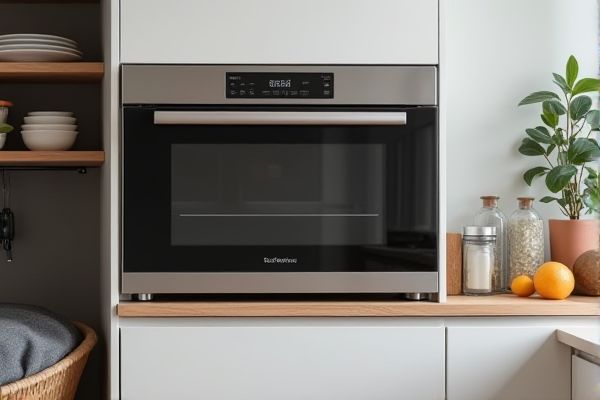
Built-in microwaves seamlessly integrate into your kitchen cabinetry, offering a sleek and space-saving solution with advanced features and higher power levels, while countertop microwaves provide portability, affordability, and simple installation ideal for small spaces or temporary setups. Discover the key differences, benefits, and considerations that will help you choose the perfect microwave to suit your cooking style and kitchen layout by reading the rest of this article.
Table of Comparison
| Feature | Built-in Microwave | Countertop Microwave |
|---|---|---|
| Installation | Integrated into kitchen cabinetry, requires professional installation | Plug-and-play, portable with no installation needed |
| Space | Saves countertop space, streamlined kitchen appearance | Occupies counter space, may clutter kitchen surfaces |
| Price | Higher initial cost including installation | Generally more affordable and budget-friendly |
| Size & Capacity | Typically larger capacity, customizable fit | Varies widely, often smaller capacity |
| Mobility | Permanently fixed, not portable | Easy to move anywhere with power outlet |
| Aesthetics | Seamless design matching kitchen decor | Visible appliance, design depends on model |
| Maintenance | Harder to clean around and repair | Easy access for cleaning and servicing |
Understanding Built-in and Countertop Microwaves
Built-in microwaves integrate seamlessly into kitchen cabinetry, offering a sleek, space-saving design that enhances your kitchen's aesthetic and frees up countertop space. Countertop microwaves provide flexible placement options and are typically more affordable and easier to install, making them ideal for renters or those frequently rearranging appliances. Understanding the size, power output, and installation requirements of each type helps you select the microwave that best fits your cooking habits and kitchen layout.
Space and Placement Considerations
Built-in microwaves save valuable countertop space by integrating seamlessly into cabinetry, making them ideal for kitchens with limited room or a streamlined design. Countertop microwaves offer flexible placement options since they do not require permanent installation, allowing users to easily move or reposition them based on kitchen layout or usage needs. Space efficiency and kitchen workflow are significantly impacted by the choice between these two types, with built-ins providing a clutter-free look and countertop units offering adaptability.
Design and Aesthetic Appeal
Built-in microwaves offer a sleek, integrated design that blends seamlessly with cabinetry, creating a streamlined and modern kitchen aesthetic. Countertop microwaves provide versatile placement options but often appear bulky and disrupt the visual flow of kitchen countertops. Choosing a built-in model enhances overall kitchen design by maintaining consistent lines and minimizing clutter.
Installation and Setup Requirements
Built-in microwaves require professional installation into cabinetry or walls, ensuring a seamless, space-saving design that enhances kitchen aesthetics. Countertop microwaves offer easy, plug-and-play setup with no installation needed, allowing flexible placement and portability. Your choice depends on your kitchen layout and how much space you want to dedicate to microwave use.
Cooking Performance and Power
Built-in microwaves generally offer higher wattage, ranging between 900 to 1200 watts, which ensures faster and more even cooking compared to countertop models that typically have 700 to 1000 watts. Their advanced cooking technology and integrated ventilation systems enhance performance by reducing cooking time and providing consistent heat distribution. Choosing the right microwave, based on power and cooking needs, ensures your meals are prepared efficiently and thoroughly.
Features and Functionality Comparison
Built-in microwaves offer seamless integration with cabinetry, providing a sleek, space-saving design and often featuring advanced options like sensor cooking and convection settings for versatile meal preparation. Countertop microwaves deliver portability and straightforward installation, with varied wattages and programmable presets ideal for everyday heating and defrosting tasks. Both types include essential features such as multiple power levels and digital controls, but built-in models tend to incorporate more sophisticated technology for enhanced cooking precision.
Maintenance and Cleaning
Built-in microwaves generally require less frequent cleaning since their design minimizes spills and splatters within your kitchen area, while countertop microwaves often accumulate debris on both the exterior and the surrounding surfaces. Your maintenance routine should consider that built-in models are integrated into cabinetry, making access for deep cleaning slightly more challenging but reducing dust accumulation around the unit. Countertop microwaves offer easier access for routine cleaning but demand more attention to prevent buildup on adjacent counters and appliance surfaces.
Cost and Value Analysis
Built-in microwaves typically cost between $600 and $1,200, providing a seamless kitchen integration that can increase home value and aesthetics, while countertop models range from $70 to $300, offering affordability and portability without permanent installation. Investing in a built-in microwave often yields long-term value through enhanced kitchen design and functionality, appealing to homeowners seeking a modern, streamlined look. Countertop microwaves deliver cost-effective performance for renters or those with limited space, emphasizing convenience over architectural enhancement.
Longevity and Durability
Built-in microwaves typically offer enhanced longevity and durability due to their integrated installation and robust construction designed for frequent use in busy kitchens. Countertop microwaves, while convenient and portable, often have a shorter lifespan as they are more exposed to physical damage and can overheat more easily. Investing in built-in models from reputable brands like Panasonic or Bosch can result in a more reliable appliance with extended operational life.
Which Microwave Suits Your Kitchen Best?
Built-in microwaves seamlessly integrate into cabinetry, saving counter space and offering a sleek, modern look ideal for kitchens with limited surface area. Countertop microwaves provide flexibility and ease of installation, making them suitable for renters or those who frequently rearrange their kitchen layout. Choosing between the two depends on your kitchen design preferences, available space, and desire for permanence versus portability.
 homyna.com
homyna.com